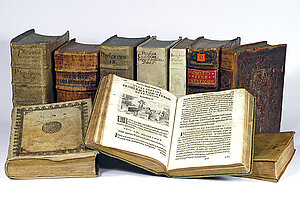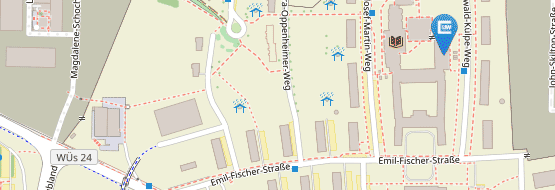Kaspar Schott
* 5. February 1608 in Königshofen † 22. May 1666 in Würzburg
1627 Entry into the Society of Jesus
1629 Study of Philosophy under Athanasius Kircher at the JMU Würzburg
1631 Escape from the Swedish troops and continuation of his Studies in Tournai (Belgium)
1633 Completion of his Philosophy-Studies
Study of Theology in Sicily
1638 Completion of his formation as a friar in Trapani (Italy)
1649 Professorship for mathematic science in Palermo
1652 Abidance in Rome to assist Athanasius Kircher
1655 Professorship for mathematic science in Würzburg
Even in the new year of 2018, the Universitätsarchiv Würzburg wants to continue its “Scholar of the Month”-Series in February by introducing the mathematician Kaspar Schott. He was in close contact with the already presented universal scholar Athanasius Kircher, who did not only teach Schott, but also supported him greatly throughout his academic career.
Scholar of the Society of Jesus
Kaspar Schott spent more than half of his lifetime with accumulating a huge spectrum of knowledge as a Jesuit, before he passed it on as a lecturer. During his time as a student in Würzburg and later in Rome, he was highly influenced by Athanasius Kircher, whom he admired exorbitantly and whom Schott regarded as his teacher over his whole life. It was not until the age of 47, that Kaspar Schott began to publish his own works, which were mostly about the findings of other scholar, rather than about his own researches.
Interest in machines
Schott received the inspiration for his first publication - the mechanica hydraulico-pneumatica - through the occupation at the private museum of his mentor Athanasius Kircher in Rome, as he had access the a variety of displayed hydraulic and pneumatic machines. The interest of many visitors into the functionality of this equipment, as well as his own interest, made Schott eager to find out more about the ‘anatomy’ of this curiosities. He could not publish his findings till he was back in Würzburg in 1657, however, as he was unable to find financial support for his plans. It was only back in Germany, while Schott had the task to campaign for the books of Athanasius Kircher, that he could make efforts to find investors for his own creation.
Back in Würzburg
In fall 1655, Kaspar Schott was sent to Würzburg by the Elector of Mainz, Johann Philipp von Schönborn, who was also the Archbishop of Würzburg at this time, in order to work on distance measurement and conduct researches on vacuum, as well as to consecrate himself again to teaching students. The Jesuit followed these requests and from now on spent his time with pursuing the elaboration of his own researches. In the following time in Würzburg up until his death in 1655, Kaspar Schott managed to publish twelve research papers within eleven years which all deal with Mathematics and its application. One can even find the influence of his Technica curiosa, which was released in 1664, within the use of today’s everyday language, as the term “Technica”, which already occurs in the title and which was created by Schott himself, is considered to be the etymological origin of the word “technique”.



